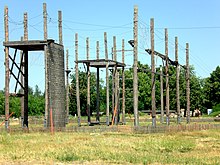Hobrechtsfelde
Hobrechtsfelde is a residential area in the west of the municipality of Panketal and belongs to the district of Zepernick . Hobrechtsfelde has about 170 inhabitants.
history
The Hobrechtsfelde estate, named on August 3, 1908 after James Hobrecht , was originally built at the beginning of the 20th century to cultivate the Berlin Rieselfelder . The building permit was granted on September 26, 1906. As early as 1911 Hobrechtsfelde received its own single-class school, which was assigned a teacher's apartment. Since the 1920s, well over 300 people have been employed in the manor facilities at peak times of the season.
In the years 1954/55 and 1958/60 several residential buildings were built, which closed the gap between the village center at the pond and festival meadow and the old estate.
1985 the sewage fields were decommissioned and with it the end of the sewage disposal around Hobrechtsfelde, remnants of the systems can be found mainly south and northeast of the place in the area.
Since January 1, 2010, the residential buildings in Hobrechtsfeld belong to the housing cooperative Bremer Höhe , based in Berlin-Prenzlauer Berg, which bought the entire village for 900,000 euros.
Hobrechtsfelder Rieselfelder
Since 1875 , Berlin wastewater has also been trickled into the north of Berlin, between Berlin-Buch and Schönwalde . This type of fertilization was mainly used for growing vegetables and the north of Berlin, especially the Buch hospitals, was supplied with agricultural products.
The sewage fields around Hobrechtsfelde have been unused since 1985. Now, in the area where Berlin's sewage was trickled out for around 100 years, a recreational area for people and a retreat for animals and plants is gradually being created.
Hobrechtsfelder Wirtschaftsbahn
Hardly paved roads and a lack of means of transport led to the expansion of a field railway network for the transport of agricultural products. From 1906, a horse-powered network of up to 60 km with a gauge of 600 mm was created. Smaller sections could be quickly relocated and dismantled as required, such as during harvest time. The Feldbahn had a connection to the Berlin-Stettiner Eisenbahn in Rüdnitz and Berlin-Buch and to the Niederbarnimer Eisenbahn in Berlin-Blankenfelde .
In Hobrechtsfelde you can still find some remains of this economic railway, especially on Hobrechtsfelder Dorfstraße. The bike and skater path runs parallel to the road on the former railway line.
Culture and sights
Visitor center Gut Hobrechtsfelde
On April 14, 2013, the Gut Hobrechtsfelde visitor center was opened on the site of the old manor . The core of the center is an exhibition on the first floor of the granary , which has thus been made accessible to the public. The exhibition presents the landscape of the Barnim Nature Park , the history of Hobrechtsfelde as well as the Berlin wastewater treatment and the radial system built for this from 1869 . The granary is accessible up to the roof, from where the surrounding landscape can be observed. There is also a display enclosure and a themed playground as well as a snack on the site.
Forest pasture
The largest German forest pasture project with 850 hectares of forest area started in 2011. Around 120 cattle and 80 Konik horses from Agrar GmbH Gut Hobrechtsfelde graze in the semi-open forest landscape on the fenced-in areas of the former sewage fields .
Stones without borders
In and around Hobrechtsfelde there has been one of the sculpture lines of the Stones Without Borders project , which in turn is part of the street of peace dreamed up by the Jewish sculptor Otto Freundlich . There are 114 sculptures on around 15 kilometers of forest and field paths, which were created in five symposia in the Buch forest between 2001 and 2012. The initiators are the sculptor Silvia Fohrer and the sculptor Rudolf J. Kaltenbach .
High rope climbing garden
Since July 2006, Hobrechtsfelde has had a high ropes course with 23 exercise elements of various degrees of difficulty, a log house and ancillary areas for sports and games on almost 17,000 m² . Reopened in May 2009 by a new operator with a family celebration, the facility was expanded to include a few elements. The climbing garden has been closed since spring 2014.
Summer night cinema
For several years there was a regular summer night cinema in Hobrechtsfelde, which had established itself with around 1000 visitors (as of 2009). In 2015, the event had to be discontinued because the costs for the conversion to the now predominantly digital film distribution could not be raised.
Web links
- History of Hobrechtsfelde
- Former sewage fields Hobrechtsfelde - Am Barnimer Dörferweg
- Berlin Forests - Rieselfelder Hobrechtsfelde
Individual evidence
- ↑ Uwe Rada: A village belongs to itself . In: The daily newspaper: taz . January 17, 2019, ISSN 0931-9085 , p. 4–5 ( taz.de [accessed January 17, 2019]).
- ↑ Hobrechtsfelde. Memorial for the Feldbahn , July 19, 2011 ( Memento from May 15, 2016 in the Internet Archive )
- ↑ Gut Hobrechtsfelde visitor center opened in Barnim Nature Park. Federal Agency for Nature Conservation, April 14, 2013 ( Memento of the original from May 10, 2016 in the Internet Archive ) Info: The archive link was inserted automatically and has not yet been checked. Please check the original and archive link according to the instructions and then remove this notice.
- ^ Homepage of Stones Without Borders , accessed on December 1, 2012
- ↑ Time out for the climbing garden. MOZ.de , June 27, 2014.
- ↑ Summer night cinema in Panketal is closed. Bernau.live on January 27, 2015.
Coordinates: 52 ° 40 ′ N , 13 ° 30 ′ E










